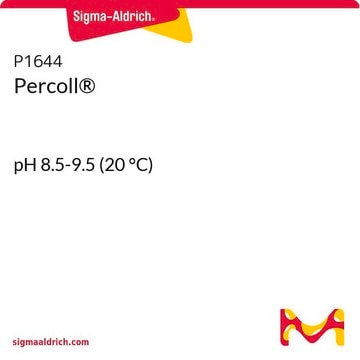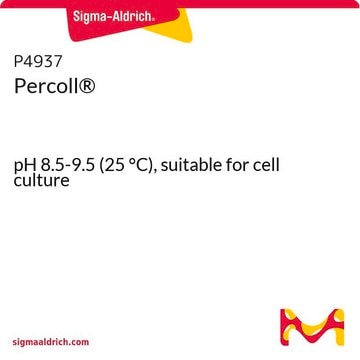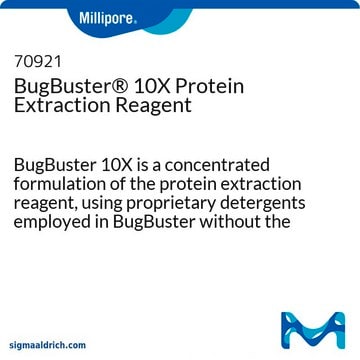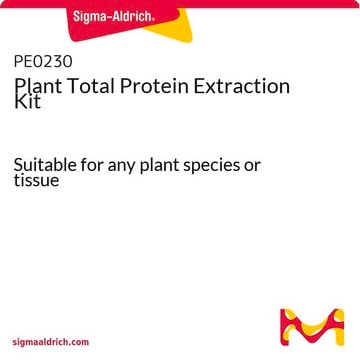CPISO
Chloroplast Isolation Kit
isolation of intact chloroplasts from leaves
Synonym(e):
Chloroplast Purification Kit, Isolation Kit for Chloroplast, Kit for Chloroplast Isolation
Anmeldenzur Ansicht organisationsspezifischer und vertraglich vereinbarter Preise
Alle Fotos(1)
About This Item
UNSPSC-Code:
12352200
NACRES:
NA.32
Empfohlene Produkte
Allgemeine Beschreibung
The Chloroplast Isolation Kit provides an efficient procedure for isolating intact chloroplasts from plant leaves. The procedure involves mechanical cell wall and cell membrane breakage, removal of cell debris and leaf tissue by filtration, collection of total cell chloroplast fraction by centrifugation, and separation of intact chloroplasts from broken chloroplasts using a Percoll® layer or gradient.
Anwendung
Chloroplast Isolation Kit may be used in chloroplast organelle research to isolate intact chloroplasts from plant leaves for structural and functional studies.
Leistungsmerkmale und Vorteile
- Specifically formulated buffer - Saves time using easy to follow simple and proven protocols
- Isolates intact chloroplasts - Useful for studies of such processes as carbon assimilation, electron flow and phosphorylation, metabolic transport or protein targeting
- Total organelle protein complement - Useful for functional studies, metabolic transport, proteomic profiling, and genomic applications
- Convenient format - Saves time and reduces waste
Eignung
The Chloroplast Isolation Kit has been tested for use with spinach, pea, lettuce, cabbage, mangold, and tobacco.
Lagerklassenschlüssel
10 - Combustible liquids
Analysenzertifikate (COA)
Suchen Sie nach Analysenzertifikate (COA), indem Sie die Lot-/Chargennummer des Produkts eingeben. Lot- und Chargennummern sind auf dem Produktetikett hinter den Wörtern ‘Lot’ oder ‘Batch’ (Lot oder Charge) zu finden.
Besitzen Sie dieses Produkt bereits?
In der Dokumentenbibliothek finden Sie die Dokumentation zu den Produkten, die Sie kürzlich erworben haben.
Kunden haben sich ebenfalls angesehen
Juan Manuel Pérez-Ruiz et al.
The Plant cell, 18(9), 2356-2368 (2006-08-08)
One of the mechanisms plants have developed for chloroplast protection against oxidative damage involves a 2-Cys peroxiredoxin, which has been proposed to be reduced by ferredoxin and plastid thioredoxins, Trx x and CDSP32, the FTR/Trx pathway. We show that rice
Yayi Tu et al.
PloS one, 10(8), e0136210-e0136210 (2015-08-27)
Potato virus Y (PVY) is an important plant virus and causes great losses every year. Viral infection often leads to abnormal chloroplasts. The first step of chloroplast division is the formation of FtsZ ring (Z-ring), and the placement of Z-ring
Yuexia Wang et al.
BMC plant biology, 20(1), 96-96 (2020-03-07)
The perturbance of chloroplast proteins is a major cause of photosynthesis inhibition under drought stress. The exogenous application of 5-aminolevulinic acid (ALA) mitigates the damage caused by drought stress, protecting plant growth and development, but the regulatory mechanism behind this
Xiaoli Luo et al.
PloS one, 8(1), e54002-e54002 (2013-01-22)
In plants, CuZn superoxide dismutase (CuZnSOD, EC l.15.1.1), ascorbate peroxidase (APX, EC 1.11.1.11), and catalase (CAT, EC l.11.1.6) are important scavengers of reactive oxygen species (ROS) to protect the cell from damage. In the present study, we isolated three homologous
The Complete Chloroplast Genome of 17 Individuals of Pest Species <I>Jacobaea vulgaris</I>: SNPs, Microsatellites and Barcoding Markers for Population and Phylogenetic Studies.
Doorduin, L., et al.
DNA Res., 1-13 (2011)
Unser Team von Wissenschaftlern verfügt über Erfahrung in allen Forschungsbereichen einschließlich Life Science, Materialwissenschaften, chemischer Synthese, Chromatographie, Analytik und vielen mehr..
Setzen Sie sich mit dem technischen Dienst in Verbindung.










